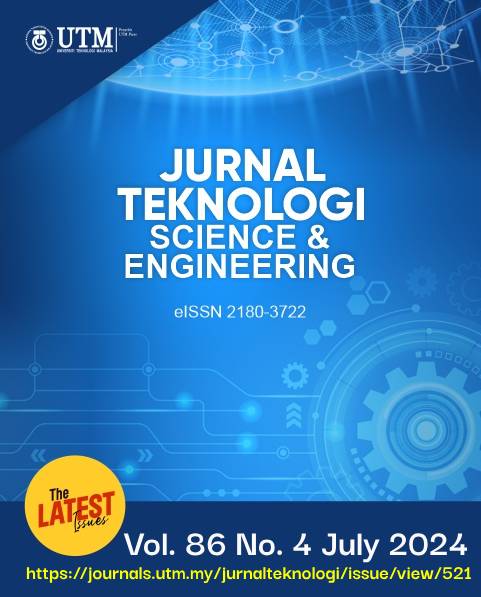NUMERICAL STUDY OF THE RESISTANCE REDUCTION IN HYBRID MINI-SUBMARINE
DOI:
https://doi.org/10.11113/jurnalteknologi.v86.20816Keywords:
Hybrid mini-submarine, resistance, hydrofoil, NACA, CFDAbstract
Hybrid mini-submarine is a single innovative ship combining the concepts of conventional fast ships, hydrofoils, and submarine with the specific mission of safeguarding national sovereignty. This study was conducted to analyze the reduction of resistance in this mini-submarine by examining the positioning and shape of NACA hydrofoils. The process involved adjusting the positions of NACA hydrofoils and incorporating different configurations. This was indicated by the inclusion of nine speed configuration in the hydrofoil mode, eight in the conventional mode, and five in the submarine mode. Moreover, Computational Fluid Dynamics (CFD) simulation was applied for analysis using the Ansys CFX software. The results showed that the positioning of the NACA hydrofoils at close proximity reduced the resistance. The selection of symmetrical and slender configuration was also observed to optimize the reduction of resistance. Moreover, the combination of position and NACA hydrofoil 0012 produced an average resistance reduction of up to 12.52%. The configured model successfully reduced the total ship resistance and also identified the optimal position and shape configuration for the NACA hydrofoils. These findings provided valuable insights into the components and characteristics of total ship resistance and served as a valuable reference for further research on the development of maritime security technology.
References
Burke, L., Reytar, K., Spalding, M., and Perry, A. 2012. Reefs at risk revisited in the Coral Triangle. World Resources Institute.
Dirhamsyah, D., Umam, S., and Arifin, Z. 2022. Maritime Law Enforcement: Indonesia’s Experience against Illegal Fishing. Ocean Coast Manag. 229: 106304.
Sakti, A. S. and Utama, I. K. A. P. 2012. Analisis CFD dan Eksperimen Hambatan Lambung Katamaran Asimetris Flat Side Outside dengan Variasi Jarak Demihull. Jurnal Teknik ITS. 1: 78-83.
Kundu, P., Sarkar, A., and Nagarajan, V. 2019. Improvement of Performance of S1210 Hydrofoil with Vortex Generators and Modified Trailing Edge. Renew Energy. 142: 643-657.
Kusuma, M. R. D. A., Chrismianto, D., and Jokosiworo, S. 2017. Pengaruh Posisi Foil Terhadap Gaya Angkat dan Hambatan Kapal Katamaran. Kapal: Jurnal Ilmu Pengetahuan dan Teknologi Kelautan. 14: 58-64.
Budiyanto, M. A., Murdianto, M. A., and Syahrudin, M. F. 2020. Study on the Resistance Reduction on High-speed Vessel by Application of Stern Foil using CFD Simulation. CFD Letters. 12: 35-42.
Kazemi Moghadam, H., Shafaghat, R., and Hajiabadi, A. 2019. Foil Application to Reduce Resistance of Catamaran under High Speeds and Different Operating Conditions. International Journal of Engineering. 32: 106-111.
Liu, S., He, G., Wang, Z., Luan, Z., Zhang, Z., Wang, W., et al. 2020. Resistance and Flow Field of a Submarine in a Density Stratified Fluid. Ocean Engineering. 217: 107934.
Sarraf, S., Abbaspour, M., Dolatshahi, K. M., Sarraf, S., and Sani, M. 2022. Experimental and Numerical Investigation of Squat Submarines Hydrodynamic Performances. Ocean Engineering. 266: 112849.
Wardhana, W., Wardhana, E. M., Soetardjo, M., and Nichita, O. F. 2021. Naval Architectural Aspects in the Design of a Hybrid Hydrofoil-submarine Craft. IOP Conference Series: Materials Science and Engineering. IOP Publishing. 012010.
Wardhana, W., Soetardjo, M., Wardhana, E., and Sujantoko, S. 2020. Analyze of Crocodile Ship Prototype Hull Resistance in Hydrofoil Mode. EasyChair.
Birk, L. 2019. Fundamentals of Ship Hydrodynamics: Fluid Mechanics, Ship Resistance and Propulsion. John Wiley & Sons.
Moonesun, M., Ghasemzadeh, F., Korol, Y., Valeri, M., Yastreba, A., and Ursalov, A. 2017. Effective Depth of Regular Wave on Submerged Submarines and AUVs. International Robotics & Automation Journal. 2: 208-216.
Huang, P., Bardina, J., and Coakley, T. 1997. Turbulence Modeling Validation, Testing, and Development. NASA Tech Memo. 110446: 10-2514.
Murai, Y., Sakamaki, H., Kumagai, I., Park, H.J., and Tasaka, Y. 2020. Mechanism and Performance of a Hydrofoil Bubble Generator Utilized for Bubbly Drag Reduction Ships. Ocean Engineering. 216: 108085.
Song, Y., Ming, P., and Yu, G. 2023. Research on Unsteady Characteristics of Different Appendaged Submarines Flows Based on Dynamic Mode Decomposition. Ocean Engineering. 276: 114189.
Hakim, M. L., Suastika, K., and Utama, I. 2023. A Practical Empirical Formula for the Calculation of Ship Added Friction-Resistance Due to (Bio) Fouling. Ocean Engineering 271(40): 113744.
Shariati, S. K. and Mousavizadegan, S. H. 2017. The Effect of Appendages on the Hydrodynamic Characteristics of an Underwater Vehicle Near the Free Surface. Applied Ocean Research. 67: 31-43.
Song, S., Terziev, M., Tezdogan, T., Demirel, Y. K., Muscat-Fenech, C. D. M., and Incecik, A. 2023. Investigating Roughness Effects on Ship Resistance in Shallow Waters. Ocean Engineering. 270: 113643.
Chillcce, G., & el Moctar, O. 2022. Viscous Effects on Squat. Applied Ocean Research. 125: 103252.
Downloads
Published
Issue
Section
License
Copyright of articles that appear in Jurnal Teknologi belongs exclusively to Penerbit Universiti Teknologi Malaysia (Penerbit UTM Press). This copyright covers the rights to reproduce the article, including reprints, electronic reproductions, or any other reproductions of similar nature.
















